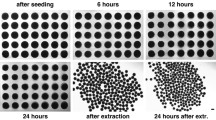Abstract
The unlimited proliferative and differentiative capacities of embryonic stem cells (ESCs) are tightly regulated by their microenvironment. Local concentrations of soluble factors, cell-cell interactions and extracellular matrix signaling are just a few variables that influence ESC fate. A common method employed to induce ESC differentiation involves the formation of cell aggregates called embryoid bodies (EBs), which recapitulate early stages of embryonic development. EBs are normally formed in suspension cultures, producing heterogeneously shaped and sized aggregates. The present study demonstrates the usage of a microfluidic traps system which supports prolonged EB culturing. The traps are uniquely designed to facilitate cell capture and aggregation while offering efficient gas/nutrients exchange. A finite element simulation is presented with emphasis on several aspects critical to appropriate design of such bioreactors for ESC culture. Finally, human ESC, mouse Nestin-GFP ESC and OCT4-EGFP ESCs were cultured using this technique and demonstrated extended viability for more than 5 days. In addition, EBs developed and maintained a polarized differentiation pattern, possibly as a result of the nutrient gradients imposed by the traps bioreactor. The novel microbioreactor presented here can enhance future embryogenesis research by offering tight control of culturing conditions.






Similar content being viewed by others
References
D.M. Adelman, M. Gertsenstein, A. Nagy, M.C. Simon, E. Maltepe, Genes Dev. 4(24), 3191–3203 (2000)
A. Bransky, N. Korin, S. Levenberg, Biomed. Microdevices 10(3), 421 (2008)
D.M. Cochran, D. Fukumura, M. Ancukiewicz, P. Carmeliet, R.K. Jain, Ann. Biomed. Eng. 34(8), 1247–58 (2006)
D. Di Carlo, L.Y. Wu, L.P. Lee, Lab Chip 6(11), 1445–49 (2006)
J. El-Ali, P.K. Sorger, K.F. Jensen, Nature 442(7101), 403 (2006)
T. Ezashi, P. Das, R.M. Roberts, PNAS; 102(13), 4783–4788 (2005)
M. Gassmann, J. Fandrey, S. Bichet, M. Wartenberg, H.H. Marti, C. Bauer et al., PNAS 93(7), 2867–72 (1996)
A.S. Gleiberman, J.M. Encinas, J.L. Mignone, T. Michurina, M.G. Rosenfeld, G. Enikolopov, Dev. Dyn. 234(2), 413–21 (2005)
Y.S. Hwang, B.G. Chung, D. Ortmann, N. Hattori, H.C. Moeller, A. Khademhosseini, PNAS 106(40), 16978–83 (2009)
E.J. Itskovitz, M. Schuldiner, D. Karsenti, A. Eden, O. Yanuka, M. Amit et al., Mol. Med. 6(2), 88–95 (2000)
M.H. Johnson, Annu Rev Cell Dev Biol (2009)
J.M. Karp, J. Yeh, G. Eng, J. Fukuda, J. Blumling, K.Y. Suh et al., Lab Chip 7(6), 786–794 (2007)
G.M. Keller, Curr. Opin. Cell Biol. 7(6), 862 (1995)
N. Korin, A. Bransky, U. Dinnar, S. Levenberg, Lab Chip 7(5), 611–617 (2007)
N. Korin, A. Bransky, M. Khoury, U. Dinnar, S. Levenberg, Biotechnol. Bioeng. 102(4), 1222–30 (2009)
H.C. Moeller, M.K. Mian, S. Shrivastava, B.G. Chung, A. Khademhosseini, Biomaterials 29(6), 752–763 (2008)
J.C. Mohr, J.J. de Pablo, S.P. Palecek, Biomaterials 27(36), 6032 (2006)
S.J. Morrison, M. Csete, A.K. Groves, W. Melega, B. Wold, D.J. Anderson, J. Neurosci. 20(19), 7370–76 (2000)
E.S. Ng, R.P. Davis, L. Azzola, E.G. Stanley, A.G. Elefanty, Blood 106(5), 1601–1603 (2005)
J.S. Odorico, D.S. Kaufman, J.A. Thomson, Stem Cells 19(3), 193–204 (2001)
J. Park, C.H. Cho, N. Parashurama, Y. Li, F. Berthiaume, M. Toner et al., Lab Chip 7(8), 1018–28 (2007)
M.J. Powers, K. Domansky, M.R. Kaazempur, A. Kalezi, A. Capitano, A. Upadhyaya et al., Biotechnol. Bioeng. 78(3), 257–269 (2002)
S. Provot, D. Zinyk, Y. Gunes, R. Kathri, Q. Le, H.M. Kronenberg, et al. J. Cell. Biol. 7;177(3), 451–64 (2007)
R. Rajpurohit, C.J. Koch, Z. Tao, C.M. Teixeira, I.M. Shapiro, J. Cell. Physiol. 168(2), 424–432 (1996)
P. Roy, H. Baskaran, A.W. Tilles, M.L. Yarmush, M. Toner, Ann. Biomed. Eng. 29(11), 947–55 (2001)
D. Shweiki, A. Itin, D. Soffer, E. Keshet, Nature 359(6398), 845 (1992)
M.C. Simon, B. Keith, Nat. Rev. Mol. Cell Biol. 9(4), 285 (2008)
A.M. Skelley, O. Kirak, R. Jaenisch, J. Voldman, uTAS 581–583 (2007)
D. Solter, J. Gearhart, Science 283(5407), 1468–70 (1999)
A. Spradling, B.D. Drummond, T. Kai, Nature 414(6859), 98 (2001)
J.A. Thomson, E.J. Itskovitz, S.S. Shapiro, M.A. Waknitz, J.J. Swiergiel, V.S. Marshall et al., Science 282(5391), 1145–47 (1998)
A. Tourovskaia, X. Figueroa-Masot, A. Folch, Lab Chip 5(1), 14–19 (2005)
M.D. Ungrin, C. Joshi, A. Nica, C. Bauwens, P.W. Zandstra, PLoS ONE 3(2), e1565 (2008)
L.G. Villa-Diaz, Y.S. Torisawa, T. Uchida, J. Ding, N.C. Nogueira-de-Souza, K.S. O'Shea, S. Takayama, G.D. Smith, Lab Chip 9(12), 1749–55 (2009)
F.M. Watt, B.L. Hogan, Science 287(5457), 1427–30 (2000)
L. Wu, D. Di Carlo, L. Lee, Biomed. Microdevices 10(2), 197 (2008)
Author information
Authors and Affiliations
Corresponding author
Additional information
Maria Khoury and Avishay Bransky equally contributed.
Rights and permissions
About this article
Cite this article
Khoury, M., Bransky, A., Korin, N. et al. A microfluidic traps system supporting prolonged culture of human embryonic stem cells aggregates. Biomed Microdevices 12, 1001–1008 (2010). https://doi.org/10.1007/s10544-010-9454-x
Published:
Issue Date:
DOI: https://doi.org/10.1007/s10544-010-9454-x




